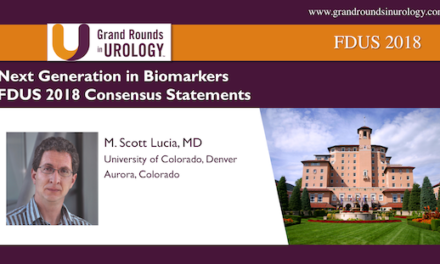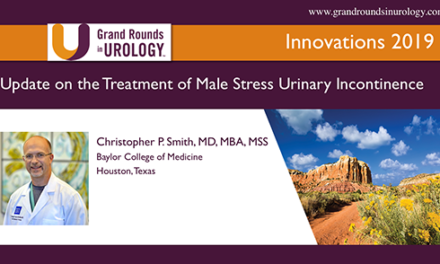Dr. Ryan P. Terlecki, MD, FACS, presented “Prostate Cancer Survivorship: Value to Patients & Providers” at the 26th Annual Perspectives in Urology: Point-Counterpoint, November 11, 2017 in Scottsdale, AZ
How to cite: Terlecki, Ryan P. “Prostate Cancer Survivorship: Value to Patients & Providers” November 11, 2017. Accessed Dec 2024. https://dev.grandroundsinurology.com/Prostate-Cancer-Survivorship/
Summary:
Dr. Ryan P. Terlecki, MD, FACS, explains why and how clinicians should not simply carry out therapies to prevent or arrest disease quickly. They should also aim to minimize possible late side effects, social hazards, and cost for their patients.
Prostate Cancer Survivorship: Value to Patients & Providers
Transcript:
So, this is going to be I think relevant for a lot of you in the audience based on getting to know some of you and what your practice is like, so we’re going to talk a little bit about what it means for effective communication with people perhaps outside your practice. So I’m going to go over and map the context of survivorship and outline some of the key players as it relates to coordinating care for your patients and then talk about survivorship care plans, and what those involve. All right, audience response. According to the American College of Surgeons, their commission on Cancer, patients choosing radical prostatectomy to treat their cancer should be provided care plans prior to surgery, within a year of diagnosis, after they receive their pathology report after, confirmation of undetectable PSA or completion of adjuvant radiation, or six months after surgery?
Prior to surgery, wow, okay. Let’s go to the next one. Let’s go back. Which of the following best approximate the incidence of impotence after radical prostatectomy, 15, 25, 50, 75, or 90%?
Okay, so it is kind of spread out with most people choosing either 50 or 75%. All right, great.
For those of you in the audience, I just put this up here to show how relevant you are nationwide. If you add up, if you are looking at the survivors in the U.S., there are 12 million Americans living with cancer, 1 in 10 households with a member diagnosed in the last 5 years. But look at these numbers, 1 in 5 are prostate cancer, another 7% are also genitourinary, so that is over a quarter of all cancers among survivors in the country, right? So that is big for urology, so Fitzhugh Mullan was a physician, was diagnosed, treated for cancer and essentially wrote what amounted to an essay in the New England Journal back in the mid-80s. And this kind of leads us into survivorship. He said, the challenge in overcoming cancer is not only to find therapies that will prevent or arrest the disease quickly, but to map the middle ground of survivorship and to minimize both its medical and social hazards, so led to a description of what patient’s rights consist of in this situation. Well to have a record and understand what they are getting as far as treatment, to know what will happen next in terms of follow-up, what late effects are possible, and then to know what is life going to be like, what do they have to look for, how do they maintain their personal health, what kinds of issues both medically but then non-medical, psychosocial, financial, and what resources are available to them. So about 12 years ago the institute of medicine released this report called from Cancer Patient to Cancer Survivor: Lost in Transition. Okay, because of poorly fragmented care, and they identified specific needs for these patients who complete treatment, and they were saying there is a lack of awareness of what these patients need and that care is just poor in terms of our communication with everyone else involved, so they called for written summaries that should include the expected recovery, the schedule of recommended follow-up screenings, what kind of information should tip patients off to recurrence of disease, and what kind of resources are available for them, so who are the key players in this process? Well, the primary care provider remains essential but I still view the cancer care provider, which may be many of you in the audience as the quarter back in this process, plus or minus a survivorship navigator, and we’ll talk about that a little bit more as we go on and plus or minus mid-levels or advanced practice professionals.
So this is a list of components that I came up with as it relates to survivorship, because even though I’m not the cancer care provider at Wake, I still direct the Prostate Cancer Survivorship Program, and you might think, well I’m only really representing a small portion of this in terms of anatomic restoration, and you will see people that treat ED and incontinence and say they run a survivorship clinic. That is only one small part of it. To really treat these patients effectively you have to consider the whole gamut of what is required. I will tell you that if you identify someone within a field of psychology who is a good provider for your patients, protect them because as soon as you tell other people about them they get so busy you can’t get anyone else in to see them, so they are worth their weight in gold.
When people say who do you use, I say I don’t have anybody. That is not entirely true, but I’m just telling you to identify these resources, and you might say well that is going to take some time, I don’t know where these resources exist. Well, I will show you something in the course of this presentation that will do that work for you.
Something we don’t talk about with our patients a lot is their financial challenges. It may involve the money they shell out for prescriptions, over-the-counter drugs, supplies, loss of income, and so these discussions only take place perhaps a third of the time. So oncology social workers if you have those are your institution and financial counselors can find resources to often be inadequate for these patients. There are actually financial counselors specific to patients with cancer. So what about physical changes in these survivors? One study estimated that about a percentage and a half of all men over the age of 45 to be cancer survivors with current adverse physical symptoms.
So the majority had symptoms at some point and about 75% currently have symptoms so in terms of importance, right, 76% of radical prostatectomy patients with impotence, 64% after radiation and hormone therapy and again those numbers will fluctuate based on what you read and I understand that. 70% will have incontinence at any time, 28% currently and then of course we’re all aware of these other physical changes. What about cognition? Well, it can be rom the disease, from the treatment, from complications, from other comorbidities or it could be just associated with the stress of having a diagnosis of cancer. So both chemotherapy and androgen deprivation have been associated with decrease in cognition and visual spatial skills. So one of the things that I see in practice is how I don’t want to say detrimental, but let’s say how tragic it can be for some patients when they are no longer able to drive. When you take away a patient’s ability to drive, it really sends them on a downward spiral, so it’s important to be aware of this.
The American College of Surgeons Commission on Cancer met in 2012 and developed standards, and these were to be implemented by 2015, so two years ago. These involved a navigation process, screening for psychosocial distress and care plans, so the navigation process is supposed to be evaluated every three years to look at what you have available in your community, barriers to care, gaps in resources, you don’t necessarily need to employ a navigator, but you need to have a process, and you can see some of the barriers there for patients in your community.
So there are a number of tools to screen for psychosocial distress, and they don’ specify that you need to use anyone in particular. In 2007, there was another report from the Institute of Medicine that called for these at a pivotal medical visit, so patients that are identified as having distress, need follow-up and if you have oncology staff there are NCI funded training programs available.
Now, this is in red so I’ll read it to you but it’s APOS-Society.org, so this is the American Psychosocial Oncology Society, and I find that a lot of people are aware that this society or unaware that this society even exists, but it’s a valuable website. So they can actually identify resources based on your zip code. So what about care plans? Well, these consist of a treatment summary and a follow-up plan, and they are now recommended for all cancer patients by the Institute of Medicine. So going back to what I said before, we need better communication among all team members.
And it is now part of a mandate, so if you are operating in a cancer center that is accredited by the American College of Surgeons, this is now a standard, and so these care plans need to be provided to patients with Stage 1, 2, or 3 cancers, treated with curative intent for their initial occurrence for those people who have completed active therapy.
So who delivers these? Does it have to be the physician? No. It can be any one of the providers listed here. If you have a credentialed navigator you can do it, but it can’t be a lay navigator. Again, this is defined in their standards as published in 2016, so it can be printed or it can be electronic incorporated into your medical record, but it has to contain input from the principal cancer care provider and team as well as input from other providers, so if you are coordinating across multiple institutions, that can be a challenge. You want to overcome the poor communication we have seen in the past.
So in all cases these groups should work together to provide the information necessary for completing the care plan containing all required elements. So what about timing? They are to be given within a year of diagnosis or 18 months if they are on long-term hormone therapy and no later than six months after completing adjuvant therapy. Providing it by mail, electronically or through a portal without discussion does not meet the standard.
So they established deadlines. By the end of this year, again linked to accreditation, these need to be provided to at least 50% or your cancer patients, and programs are required to track and report the number provided.
So ASCO met in 2012 to develop a strategy, and they found that these care plans were not going to be done if it was too onerous for providers, and so they assembled a group of what they felt to be stakeholders to determine how best to do this. So the treatment plan, so there are two key documents, right a treatment plan when the patient initiates treatment, and a survivorship plan, which includes a summary of what you received and your plan for follow up, so in the summary of your treatment, your treatment summary these were the components that they felt to be important right so specifically explain the diagnosis, the stage, what they’ve received and when, ongoing toxicity or adverse events of all treatment received are also included as well as information in the likelihood of recovery, perhaps relevant to allow the talks at this meeting genetic or hereditary risk factors were also listed.
So what about the follow up plan? Again, you need information on the cancer care provider, adjuvant therapy, the schedule in a formatted table, and general statements regarding their follow up with their regular doctor and reporting of symptoms a list of resources and general statements as it relates to their overall health.
So what are the barriers? The biggest one that people perceive almost immediately is time, right, time and resources. The work group found it took about ten minutes once they trained a nurse to do this. Another concern was inadequate reimbursement and challenges in coordinating care and incomplete penetrance of electronic health records.
So ASCO came up with a list of guidelines as it relates to prostate cancer survivorship endorsing the American College guidelines from 2014 1ith some minor modifications and qualifying statements, they have 39 recommendations, four were actually on sexual dysfunction, 3 on intimacy, and again what about implementation, so think time, think resources, only 20% of oncologists report consistently providing care plans, and only 13% of primary care doctors report consistently receiving them, however, if these primary care docs receive these care plans, they were nine times more likely to discuss survivorship with survivors, and the more often they get them the more confident they are managing late-term consequences. So in terms of timing, cancer care providers of one study felt that 3 to 6 months after treatment was optimal, the existence of your program however should be mentioned to patients at the time of diagnosis. Patients like to know that they are in good hands, they like to know they have a team looking out for them, but you need to make the process easy, so the most widely endorsed strategy is a template with pre-specified fields and now there are resources to make this easier.
So I presented this at LUGPA at the meeting in Denver last year, so these are now produced by Boston Scientific, okay, these are unbranded and they will customize these to your practice, change the graphics, put the provider or you know the group of providers here, right, and then they have everything there for you, and they even have local representatives so if you say they come to you and say who is your go to for pelvic floor physical therapy, for financial counseling for patients, or this, that, and the other to fill out all of these pre-specified fields, if you say, well, these are my people, and they will put their name so it is printed and already in the template, if you say I don’t have resources for these certain things they will find them for you, okay so I developed this with industry and it has been rolled out nationally and it’s been a positive piece for encouraging better communication among team members.
So what about anatomic restoration? As I mentioned this is just a small component, but as a reconstructive urologist this is a big part of what I do. These are important elements. We already spoke about the sexual and urinary health needs of patients yesterday. But there is an opportunity for cancer care providers to form an effective team with prosthetic urologists, so the more volume seen by prosthetic urologists, the better their outcomes, the same thing with cancer physicians, right, the more you do the better you get, but it’s important for people who do the same type of work that I do to recognize that the cancer care provider needs to remain the quarterback because that is still the focus of their overall situation, prioritizing cancer care. I think a lot of it boils down to better communication skills. There are some barriers right, to involving another urologist sometimes in the care of a patient, and we found that through better education, I would say better use of certain words that you can kind of overcome some of those barriers effectively and to the betterment of patient care.
So another thing I’ve been asked about is we taught a course at the AUA previously on shared medical appointments so when we think about the time involved in filling out these care plans, it seems ideally suited to a shared appointment, and those are billable. Right? They can’t just be a lecture as per the guidelines, but those are billable, and you have to give the patients the option to ask their questions directly and so forth.
I also talked about how just doing pre-op shim scores can be helpful, not only for the survivorship part of it, but also for reimbursement, so let’s go back to our questions.
Okay, so going back to what the ACS has established, patients choosing radical prostatectomy should be provided plans when prior to surgery, within a year of diagnosis, after they get their path report, after confirmation of undetectable PSA or completion of adjuvant radiation if planned or six months after surgery?
Great so most of you got the correct answer. Let’s go to the next one. Which of the following best approximates the incidence of impotence after radical prostatectomy?
And D is correct.
So in conclusion survivorship requires a multi-faceted team-based approach, care plans are now an essential and mandated part of cancer survivorship, so better communication should translate into better cancer care, compliance from patients, quality of life and satisfaction scores, which are important to all of us, and resources exist now to make this process easier. Thank you.
ABOUT THE AUTHOR
Ryan P. Terlecki, MD, is a reconstructive urologist for Wake Forest Baptist Health, an academic Level 1 trauma center in Winston-Salem, North Carolina. His positions include Vice Chair and Associate Professor of Urology, Director of the Men’s Health Clinic, Director of Medical Student Education, and Fellowship Director for Reconstructive Urology. He is also the President of the North Carolina Urological Association. His publications cover multiple areas of trauma and reconstruction and his research is focused primarily on models of wound healing and regeneration in the lower genitourinary system. Dr. Terlecki completed two separate fellowships in reconstructive surgery following his residency, and is a member of the Society of Genitourinary Reconstructive Surgeons (GURS). Dr. Terlecki’s areas of expertise include urethral stricture disease, male sexual dysfunction, male incontinence, Peyronie’s disease, chronic testicular pain, hypogonadism, and infertility.





